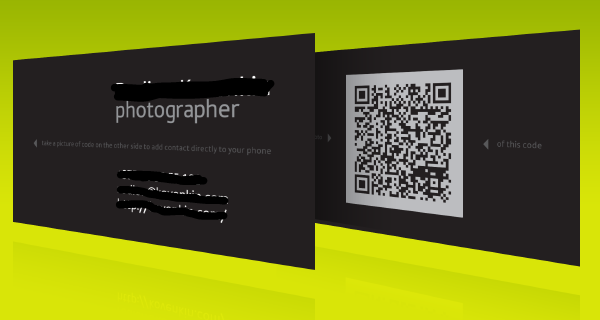Each business card has its own QR code.

The issue of transferring personal contact information was, is and will be relevant. How is the transfer of contacts in the modern world?
The most common way is to read the digits of your number to the other person. The latter enters information into a paper archive or telephone. There is a big minus in the papers - poor cataloging and inconveniently implemented search. It’s easier with the phone, but it’s all the same time. You need to get the phone from your pocket, man’s purse, backpack (or where else do mobile phones carry?), Unlock and only then panic dial the numbers. And in a hurry, the fingers do not obey and poke anywhere.
Imagine the situation: you are a cool employee in some respectable company. You go to work in the morning in a minibus (you only work half a year and haven’t earned a car yet) and in the crowd you recognize a classmate with whom you sat at the same desk. By the way, you have not seen each other for a long time, but rather, you have not seen each other since graduation. You learn from each other how you are doing, everything is cool, you start talking about your cool work. You talk so much that you almost miss your stop. You need to run out, but you don’t want to part for several years again, you need to take at least a number ... You panicked your palms in your pockets to find a mobile phone and so on. Is that familiar?
Exit - business cards. With us (the inhabitants of the post-Soviet space), they are just beginning to gain popularity in everyday life. I do not mean corporate business cards, but ordinary ones, with a full name, contact number and email. True, in a previous story you would have dreamed of a personal business card that you can just get and give?

While the culture of business cards gets to us (in a couple of years), I will talk about minus business cards. In fact, a business card is an ordinary part of a paper archive. Like in the first example. Keeping business cards is inconvenient, these are not bytes of information, but kilograms of paper in the future. Exit - business cards must be digitized. You can scan, for example. So they will not take up space, but there will remain problems with the search for information. There are special utilities with which you can read the text of a business card, simultaneously converting it into a digital format. For a computer, such programs are enough, and they recognize both English and Russian text. But the procedure is not easy: save the business card itself, scan, recognize and save information. For mobile devices, text recognition utilities are also enough, but support for the Russian alphabet is still in short supply. And again there is a solution!
Attention, visit the future! In 1994, the Japanese company Denso-Wave invented and developed a matrix code (two-dimensional barcode) - a QR code.

The acronym QR is derived from English. “Quick response”, which translates as “quick response”. And the explanation is “for people”: a QR code is a small square, inside of which there are many small squares located, at first glance, in an arbitrary sequence. Such a blot of the future can contain a lot of information, including all contact information about your person. Warmer? By placing such a box on your business card, you will greatly facilitate the storage of information for anyone who receives a business card. The recipient just needs to point the mobile camera at a two-dimensional code and all the information will be in his phone and it can be immediately saved to contacts.
It’s hard for me to imagine a mobile operating system on which an application for reading two-dimensional baracodes has not been released. Hard - because there is no such platform. Even dialers can do this. The only limitation is the camera. She must be. Just to be, even aphthofocus is not necessary, although it is welcome.
There are also enough services for creating QR codes. Here is one of them - http://qrcode.kaywa.com/ . Just fill in the necessary information in the field and click "Generate!".

The resulting code can be saved as an image, and then placed on a business card layout. There you can download the application for a mobile device. Everything, life has become a little easier!

Currently, the QR code is widely distributed in Asia (especially in Japan), is gradually developing in Europe and North America. He received the greatest recognition among mobile users - by installing a recognizer program, a subscriber can instantly enter text information into his phone, add contacts to his address book, follow web links, send SMS messages, etc.
In Japan, similar codes are applied to almost all goods sold in stores, they are placed in advertising booklets and reference books. With the help of a QR code they even organize various contests and role-playing games. ( from Wikipedia )
Believe me, it would be easier for us to live if everyone enjoyed the benefits of modern technology.
